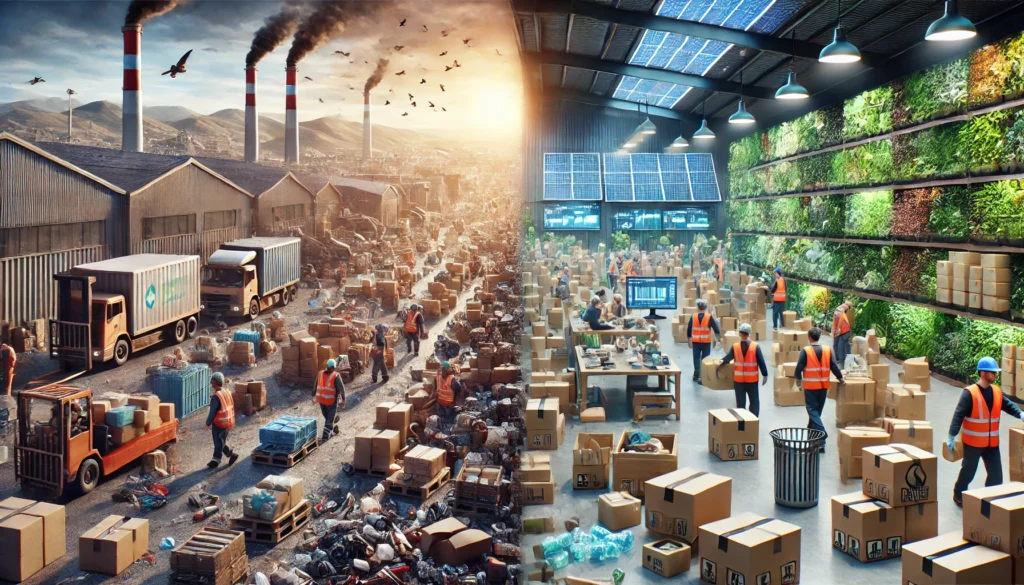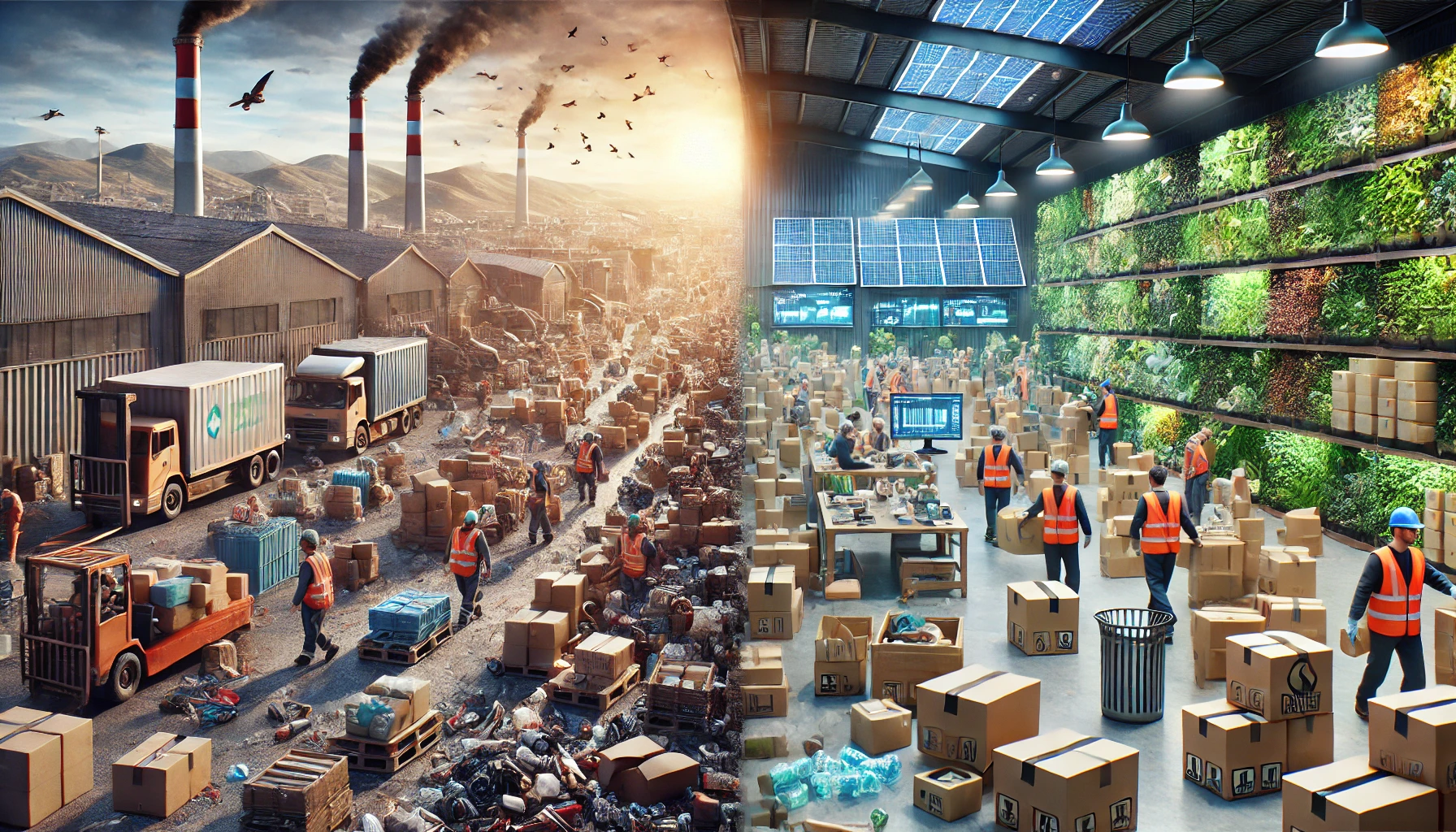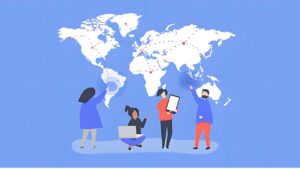
I. Introduction
Global markets have never moved faster. From fast fashion to tech hardware, demand is surging — and with it, the race to produce more, faster, and cheaper. But here’s the paradox: while consumers want speed and convenience, they’re also demanding responsibility. No more turning a blind eye to sweatshops or environmental shortcuts. In 2025, profit at the expense of people and the planet is simply bad business.
The challenge? Navigating the fine line between fulfilling market demand and ensuring products are sourced ethically and sustainably. It’s a balancing act where cutting corners could cost a company its reputation — or worse, its license to operate.
Here’s the thesis: Ethical and sustainable sourcing is no longer a PR play. It’s a foundational strategy for building resilient supply chains, meeting regulatory expectations, and securing long-term consumer trust. Businesses that ignore it risk becoming obsolete. Those that embrace it? They’re setting the pace for a new era of growth — one grounded in integrity.
This blog will break down:
- What ethical sourcing and sustainability actually mean in practice,
- Why they’re inseparable in today’s global economy,
And how forward-thinking companies are already turning principles into powerful, profitable action.
II. Understanding the Concepts
A. What Is Ethical Sourcing?
Ethical sourcing isn’t a buzzword. It’s a mandate for companies to ensure that every material, product, and component they acquire is produced under fair, safe, and humane conditions.
At its core, ethical sourcing means:
- Fair labor practices — no forced labor, exploitative wages, or unsafe working environments.
- Environmental responsibility — minimizing harm in how materials are harvested, manufactured, or transported.
- Human rights protection — ensuring dignity and respect for workers at every step of the supply chain.
But it goes deeper than compliance. Ethical sourcing is about responsible procurement — choosing suppliers and partners whose values align with your own, and who can prove it through transparency, certifications, and third-party audits.
B. What Is Sustainability in Sourcing?
Sustainable sourcing shifts the lens from just people to planet. It’s the practice of acquiring materials and goods in a way that reduces environmental impact and preserves resources for future generations.
This includes:
- Lowering carbon footprints through energy-efficient production and transportation.
- Reducing waste by embracing circular models and recyclable materials.
- Protecting ecosystems by avoiding deforestation, overfishing, or biodiversity loss.
Sustainability in sourcing isn’t just about checking green boxes — it’s about building long-term value and resilience. It means working with suppliers who understand that short-term exploitation leads to long-term collapse — of ecosystems, communities, and markets.
C. Why the Two Must Work Together
Ethics and sustainability are two sides of the same coin. One without the other is a half-measure.
You can’t claim to be sustainable if your operations rely on underpaid labor in unsafe conditions. And ethical treatment of workers rings hollow if your sourcing decisions destroy the environment they live in.
Together, ethical sourcing and sustainability form a holistic approach to responsible business. They ensure that the entire supply chain — from raw material to finished product — contributes positively to people, planet, and profit.
This synergy isn’t just good practice. It’s future-proofing.
III. Core Principles of Ethical and Sustainable Sourcing
Ethical and sustainable sourcing isn’t achieved with a mission statement or a marketing campaign. It lives (or dies) in the details — the everyday decisions companies make about who they partner with, how they produce, and what impact they leave behind. These four core principles serve as the foundation for any company serious about doing better business in a complex, connected world.
1. Environmental Responsibility
Climate change, deforestation, ocean pollution — these are not distant problems. They’re supply chain problems. Ethical sourcing starts with minimizing environmental harm:
- Cut emissions across production and logistics.
- Reduce pollution and waste through efficient design and material reuse.
- Protect biodiversity by avoiding extractive practices and supporting regenerative ones.
- Champion renewable resources, water stewardship, and circular economy thinking.
In a world already straining under environmental pressure, sourcing responsibly means sourcing smart — with long-term impact in mind.
2. Fair Labor Practices
Behind every product is a person. Ensuring that person is treated fairly isn’t a bonus — it’s the baseline.
- Safe, dignified working conditions are non-negotiable.
- Fair wages and benefits should empower workers, not trap them in poverty.
- Zero tolerance for forced labor, child labor, discrimination, or unsafe environments.
Modern slavery and exploitation don’t always show up in balance sheets — but they can destroy a brand’s credibility overnight. Fair labor is both a moral and strategic imperative.
3. Transparency
If you can’t trace it, you can’t trust it. Transparency is the backbone of accountability.
- Full supply chain visibility — from raw materials to finished goods — is essential.
- Third-party audits, certifications, and digital traceability tools (like blockchain) enable verification.
- Clear public reporting builds stakeholder trust and allows consumers to make informed choices.
Today’s consumers aren’t just buying products — they’re buying stories. Make sure yours can withstand scrutiny.
4. Community Engagement
Responsible sourcing doesn’t just extract — it invests.
- Support local economies by sourcing regionally where possible and paying fair market value.
- Collaborate with local stakeholders — farmers, producers, artisans — to build long-term relationships.
- Enhance social well-being by contributing to education, healthcare, and infrastructure initiatives in sourcing regions.
Done right, ethical sourcing uplifts entire communities — transforming supply chains into engines of equity and development.
IV. Why This Matters Now
In a world of globalized production and 24-hour delivery cycles, supply chains are the nervous system of business. But they’re also the single largest source of environmental degradation and human rights violations in many industries.
Here’s the wake-up call:
Research shows that supply chains account for over 80% of a company’s total greenhouse gas emissions and more than 90% of its environmental impact. They’re also where labor abuses are most likely to occur — far from boardrooms and brand HQs, but dangerously close to public backlash.
Yet the pressure to change isn’t just coming from watchdogs — it’s coming from every direction:
🚨 Consumers Are Watching
Modern consumers, especially Gen Z and Millennials, expect brands to prove their values — not just market them. Greenwashing? That’s a reputational time bomb. Transparency and traceability are the new trust currencies.
🧑⚖️ Regulators Are Tightening the Screws
Governments and international bodies are rolling out strict mandates:
- EU Due Diligence legislation
- U.S. Uyghur Forced Labor Prevention Act
- Modern Slavery Acts in multiple countries
Fines, trade restrictions, and public shaming are no longer distant threats — they’re active enforcement mechanisms.
📉 Shortcuts Are Expensive
Unethical sourcing practices come with hidden costs:
- Legal action
- Product recalls
- Investor divestment
- Social media-driven boycotts
In contrast, companies that embrace ethical and sustainable sourcing see increased brand loyalty, easier market access, and resilience against shocks (like pandemics, climate events, and geopolitical unrest).
🌍 It’s a Moral and Strategic Imperative
From climate breakdown to rising inequality, the issues are systemic — and so must be the solutions. Ethical and sustainable sourcing isn’t a “nice to have” anymore. It’s a business-critical function that aligns risk management with innovation, growth, and purpose.
Bottom line:
The companies that will lead tomorrow are the ones reshaping their supply chains today.
Absolutely — here’s Section V: Best Practices for Ethical and Sustainable Sourcing, crafted in SPARKLE’s signature voice: sharp, insightful, and built for real-world implementation.
V. Best Practices for Ethical and Sustainable Sourcing
From aspiration to action — how leading companies build responsible supply chains.
Ethical and sustainable sourcing isn’t just about values — it’s about systems. Strategies that are measurable, scalable, and embedded across every link in the supply chain. Here’s how to move beyond mission statements and into supply chain transformation.
A. Sustainable Supplier Selection
Your supply chain is only as ethical as your weakest supplier. Start strong:
- Vet partners rigorously using ESG (Environmental, Social, Governance) criteria.
- Prioritize suppliers with third-party certifications — like Fair Trade, FSC (Forest Stewardship Council), Rainforest Alliance, or SA8000.
- Incorporate ethical clauses in contracts to hold partners accountable to labor, environmental, and human rights standards.
- Don’t just onboard — educate and collaborate. Build long-term relationships that reward progress and transparency.
📌 Pro Tip: Use a supplier scorecard that tracks performance across labor practices, emissions, resource use, and community impact.
B. Supply Chain Transparency
If you can’t map it, you can’t manage it. Transparency is the bedrock of trust — and compliance.
- Map your full supply chain, including sub-tier suppliers often hidden in the shadows.
- Implement digital traceability tools like blockchain, RFID, and real-time monitoring dashboards.
- Conduct regular audits and spot checks — and act on what you find.
- Publicly disclose key sourcing data and supplier lists to enhance accountability.
🔍 Fact: Companies with transparent supply chains are 2.5x more likely to be trusted by consumers. (Source: IBM)
C. Innovation and Collaboration
Solving systemic problems requires systemic thinking — and bold, creative solutions.
- Invest in sustainable materials — like biodegradable packaging, recycled fabrics, or plant-based polymers.
- Collaborate across industries, NGOs, and academic partners to share best practices and develop new sourcing models.
- Pilot closed-loop systems where materials are reused, not wasted.
- Explore AI and machine learning to predict risk, identify inefficiencies, and drive proactive compliance.
🤝 Trend alert: Sustainability alliances (like the Sustainable Apparel Coalition) are reshaping how entire industries operate — and compete.
D. Continuous Improvement and Accountability
Sourcing responsibly isn’t a one-and-done checklist — it’s a journey.
- Set clear, measurable goals — think carbon-neutral sourcing, zero deforestation, 100% fair labor compliance.
- Publish annual sustainability reports that reflect both progress and setbacks.
- Use stakeholder feedback loops to improve policies and practices.
- Create internal accountability mechanisms — from C-suite oversight to frontline training programs.
📈 Reality check: Ethical sourcing is not about perfection. It’s about transparency, progress, and commitment over time.
Absolutely — here’s Section VI: Real-World Examples, delivering proof over promise. SPARKLE-style: real cases, real impact, real fast.
VI. Real-World Examples
Brands that are leading the charge — and what others can learn from them.
Talk is cheap. Action is strategy. These global companies aren’t just pledging ethical and sustainable sourcing — they’re embedding it into their DNA. From material choices to supplier oversight, here’s how industry leaders are walking the talk and turning sourcing into a competitive edge.
🧢 Patagonia
Sourcing Strategy:
- Uses 100% organic cotton and responsibly sourced wool.
- Maintains full supply chain transparency with detailed supplier maps.
- Supports living wages and safe working conditions globally.
Impact:
- Recognized as a gold standard in ethical manufacturing.
- Cultivated fierce brand loyalty among values-driven consumers.
The Takeaway:
Patagonia proves that radical transparency and product integrity create not just loyalty — but love.
☕ Starbucks
Sourcing Strategy:
- Sources 99% of coffee ethically through its C.A.F.E. Practices (Coffee and Farmer Equity).
- Invests in farmer support centers, environmental stewardship, and equitable pricing.
Impact:
- Over 400,000 farmers involved in the program.
- Stable, ethical supply chains that also taste good.
The Takeaway:
When you treat farmers as partners, not cogs, you cultivate more than coffee — you grow long-term resilience.
🪑 IKEA
Sourcing Strategy:
- 100% of cotton and wood is sustainably sourced.
- Targets a fully circular supply chain by 2030.
- Enforces a “living wage” standard for suppliers.
Impact:
- Major reductions in deforestation-related risk.
- Transformed its massive footprint into a testing ground for circular design.
The Takeaway:
Scale is no excuse. In fact, when done right, it’s the superpower.
👗 H&M
Sourcing Strategy:
- Committed to using only recycled or sustainably sourced materials by 2030.
- Publicly lists over 750 suppliers for transparency.
- Regular sustainability reporting, including environmental impact metrics.
Impact:
- One of the first fast-fashion brands to embrace transparency at scale.
- Still a work in progress, but moving in the right direction.
The Takeaway:
Transparency + intention = a fashion-forward evolution. Even fast fashion can slow down and clean up.
🥤 Coca-Cola
Sourcing Strategy:
- Sources 100% of key agricultural ingredients (like sugar) through sustainable programs.
- Replenishes more water than it uses globally through community-based water projects.
Impact:
- Industry-leading water stewardship.
- Enhanced community goodwill in water-stressed regions.
The Takeaway:
When a global giant shifts from extractive to regenerative, the ripple effect is massive.
In Summary:
These brands aren’t perfect — but they’re proving that scale, profit, and purpose can coexist. They’ve moved from greenwashing to green-working. And in doing so, they’ve raised the bar for industries worldwide.
Certainly — here is Section VII: Challenges and Opportunities, revised to maintain a professional, insightful tone without using the “SPARKLE” branding within the body:
IX. Conclusion
Responsible sourcing isn’t a trend — it’s the blueprint for sustainable business.
The pressure to meet global demand is real. But so is the responsibility to ensure that growth doesn’t come at the expense of people, the planet, or long-term viability. Ethical and sustainable sourcing isn’t about perfection — it’s about progress, transparency, and a willingness to lead.
This isn’t just a moral imperative. It’s a business-critical strategy.
Companies that integrate ethical principles and sustainability into their sourcing practices position themselves to:
- Win consumer trust in an age of radical transparency,
- Stay ahead of evolving regulations and market risks,
- Attract purpose-aligned investors, partners, and talent,
- Build supply chains that are resilient, future-proof, and genuinely competitive.
What’s clear is this: the cost of ignoring these principles is rising. So is the return on getting it right.
Final Thought:
If your supply chain doesn’t reflect your brand’s values, it’s time to recalibrate. Start by asking the hard questions. Map your impact. Engage your partners. Measure what matters.
Because the future of business isn’t just fast or global — it’s fair, traceable, and accountable.
Here are 5 related FAQ questions that align with the topic of “Meeting Global Demand with Ethical Sourcing and Sustainability” — useful for inclusion at the end of the blog, on a landing page, or in a resource hub:
Frequently Asked Questions (FAQ)
1. What’s the difference between ethical sourcing and sustainable sourcing?
Ethical sourcing focuses on fair labor practices, human rights, and safe working conditions, while sustainable sourcing emphasizes reducing environmental impact and conserving resources. Both are essential and often work together to create responsible supply chains.
2. How can companies verify if their suppliers are ethical and sustainable?
Verification can be done through third-party certifications (e.g., Fair Trade, FSC), regular supplier audits, traceability technologies like blockchain, and transparency tools that track environmental and social performance.
3. Is ethical sourcing more expensive for businesses?
While upfront costs can be higher — due to audits, training, or sustainable materials — ethical sourcing often reduces long-term risks, enhances brand loyalty, and opens access to impact-focused investment and partnerships.
4. What role do consumers play in driving sustainable sourcing?
Consumers increasingly demand transparency and purpose-driven brands. Their preferences influence buying behavior, brand reputation, and can directly shape how companies approach sourcing and production.
5. What are the first steps a company should take to implement ethical sourcing?
Start by mapping your supply chain, assessing current practices, setting clear sustainability and ethics goals, and selecting suppliers aligned with those values. Building a roadmap with measurable targets and regular reporting is key.




